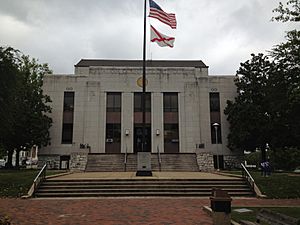Walker County, Alabama facts for kids
Quick facts for kids
Walker County
|
||
|---|---|---|

Walker County Courthouse in Jasper
|
||
|
||

Location within the U.S. state of Alabama
|
||
 Alabama's location within the U.S. |
||
| Country | ||
| State | ||
| Founded | December 26, 1823 | |
| Named for | John Williams Walker | |
| Seat | Jasper | |
| Largest city | Jasper | |
| Area | ||
| • Total | 805 sq mi (2,080 km2) | |
| • Land | 791 sq mi (2,050 km2) | |
| • Water | 14 sq mi (40 km2) 1.7% | |
| Population
(2020)
|
||
| • Total | 65,342 | |
| • Estimate
(2023)
|
64,728 |
|
| • Density | 81.17/sq mi (31.340/km2) | |
| Time zone | UTC−6 (Central) | |
| • Summer (DST) | UTC−5 (CDT) | |
| Congressional district | 4th | |
|
||
Walker County is a county located in the central portion of the U.S. state of Alabama. As of the 2020 census, the population was 65,342. Its county seat is Jasper. Its name is in honor of John Williams Walker, the first U.S. senator elected from Alabama.
Walker County comprises the entirety of the Jasper, AL Micropolitan Statistical Area.
Contents
History
Walker County was established on December 26, 1823, and formed from sections of Marion and Tuscaloosa counties. It was named after Senator John Walker, who represented Alabama in the U.S. Senate from 1819 to 1822. The county was greatly reduced in size on February 12, 1850, when its northern half became the county of Winston. Jasper is the county seat, and was named after William Jasper, a Revolutionary War hero from South Carolina.
National Register of Historic Places
Walker County has sites listed on the National Register of Historic Places. They include the Bankhead House, Boshell's Mill, the First United Methodist Church of Jasper, the Gilchrist House, the Jasper Downtown Historic District, the Stephenson House, and Walker County Hospital.
Geography
According to the United States Census Bureau, the county has a total area of 805 square miles (2,080 km2), of which 791 square miles (2,050 km2) is land and 14 square miles (36 km2) (1.7%) is water. The county is located in the Cumberland Plateau region, with many plateaus and valleys, along with many forested areas, covering the county.
Adjacent counties
- Winston County (north)
- Cullman County (northeast)
- Blount County (east)
- Jefferson County (southeast)
- Tuscaloosa County (southwest)
- Fayette County (west)
- Marion County (northwest)
Demographics
| Historical population | |||
|---|---|---|---|
| Census | Pop. | %± | |
| 1830 | 2,202 | — | |
| 1840 | 4,032 | 83.1% | |
| 1850 | 5,124 | 27.1% | |
| 1860 | 7,980 | 55.7% | |
| 1870 | 6,543 | −18.0% | |
| 1880 | 9,479 | 44.9% | |
| 1890 | 16,078 | 69.6% | |
| 1900 | 25,162 | 56.5% | |
| 1910 | 37,013 | 47.1% | |
| 1920 | 50,593 | 36.7% | |
| 1930 | 59,445 | 17.5% | |
| 1940 | 64,201 | 8.0% | |
| 1950 | 63,769 | −0.7% | |
| 1960 | 54,211 | −15.0% | |
| 1970 | 56,246 | 3.8% | |
| 1980 | 68,660 | 22.1% | |
| 1990 | 67,670 | −1.4% | |
| 2000 | 70,713 | 4.5% | |
| 2010 | 67,023 | −5.2% | |
| 2020 | 65,342 | −2.5% | |
| 2023 (est.) | 64,728 | −3.4% | |
| U.S. Decennial Census 1790–1960 1900–1990 1990–2000 2010–2020 |
|||
2020 census
| Race / Ethnicity (NH = Non-Hispanic) | Pop 2000 | Pop 2010 | Pop 2020 | % 2000 | % 2010 | % 2020 |
|---|---|---|---|---|---|---|
| White alone (NH) | 64,855 | 60,587 | 56,394 | 91.72% | 90.40% | 86.31% |
| Black or African American alone (NH) | 4,323 | 3,885 | 3,889 | 6.11% | 5.80% | 5.95% |
| Native American or Alaska Native alone (NH) | 197 | 233 | 187 | 0.28% | 0.35% | 0.29% |
| Asian alone (NH) | 140 | 190 | 283 | 0.20% | 0.28% | 0.43% |
| Pacific Islander alone (NH) | 13 | 26 | 2 | 0.02% | 0.04% | 0.00% |
| Other race alone (NH) | 18 | 36 | 136 | 0.03% | 0.05% | 0.21% |
| Mixed race or Multiracial (NH) | 560 | 759 | 2,299 | 0.79% | 1.13% | 3.52% |
| Hispanic or Latino (any race) | 607 | 1,307 | 2,152 | 0.86% | 1.95% | 3.29% |
| Total | 70,713 | 67,023 | 65,342 | 100.00% | 100.00% | 100.00% |
As of the census of 2020, there were 65,342 people, 25,153 households, and 17,410 families residing in the county.
2010 census
As of the census of 2010, there were 67,023 people, 26,571 households, and 18,741 families living in the county. The population density was 85 people per square mile (33 people/km2). There were 30,816 housing units at an average density of 38 units per square mile (15 units/km2). The racial makeup of the county was 91.2% White, 5.9% Black or African American, 0.4% Native American, 0.3% Asian, 0.1% Pacific Islander, 1.0% from other races, and 1.2% from two or more races. Nearly 2.0% of the population were Hispanic or Latino of any race. There were 26,571 households, 26.8% had children under the age of 18 living with them; 52.0% were married couples living together, 13.3% had a female householder with no husband present, and 29.5% were non-families. 25.8% of households were made up of individuals, and 11.2% were one person aged 65 or older. The average household size was 2.49, and the average family size was 2.97.
The age distribution was 22.5% under the age of 18, 8.1% from 18 to 24, 24.4% from 25 to 44, 28.7% from 45 to 64, and 16.3% 65 or older. The median age was 41.2 years. For every 100 females, there were 95.1 males. For every 100 females age 18 and over, there were 97.8 males.
The median household income was $37,191 and the median family income was $45,788. Males had a median income of $43,671 versus $27,662 for females. The per capita income for the county was $20,516. About 14.7% of families and 18.6% of the population were below the poverty line, including 27.5% of those under age 18 and 12.4% of those age 65 or over.
Economy
Local officials have described coal mining as "literally at the core" of the county's economy.
Transportation
Major highways
 Interstate 22
Interstate 22 U.S. Highway 78
U.S. Highway 78 State Route 5
State Route 5 State Route 13
State Route 13 State Route 18
State Route 18 State Route 69
State Route 69 State Route 102
State Route 102 State Route 118
State Route 118 State Route 124
State Route 124 State Route 195
State Route 195 State Route 257
State Route 257 State Route 269
State Route 269
Rail
- BNSF Railway
- Norfolk Southern Railway
Communities
Cities
- Carbon Hill
- Cordova
- Dora
- Jasper (county seat)
- Sumiton (partly in Jefferson County)
Towns
Unincorporated communities
- Aldridge
- Argo
- Benoit
- Boldo
- Burnwell
- Coal Valley
- Corinth
- Corona
- Curry
- Dogtown
- Empire
- Goodsprings
- Gorgas (partly in Tuscaloosa County)
- Hilliard
- Lupton
- Manchester
- McCollum
- Mount Hope
- Patton
- Quinton
- Saragossa
- Slicklizzard
- Spring Hill
- Townley
- Union Chapel
Places of interest
Walker County is home to the William B. Bankhead National Forest and Lewis Smith Lake, in addition to the Alabama Mining Museum.
See also
 In Spanish: Condado de Walker (Alabama) para niños
In Spanish: Condado de Walker (Alabama) para niños


